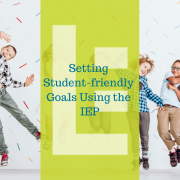Setting Student-friendly Goals Using the IEP
Calling the average Individualized Education Program (IEP) document bulky would be an understatement. Even for educators, who are quite familiar with special education documentation, the length of the IEP can make it difficult to cull the student goals. Even more taxing is the task of deciphering the IEP goals in a way that can be clearly and concisely explained to parents and students. However, since IEP goals are aligned to state and grade-level standards, they offer families a sound starting point for making their own student-friendly, SMART goals.
What is a SMART goal?
SMART is an acronym, often used in educational environments, to help students through the process of goal setting. Using the acronym, students should make sure that goals are specific, measurable, achievable, results-oriented, and time-bound.
- A specific goal is one that takes the student’s current functionality into account: Where is he currently in his academic achievements and where does he need to be? In answering these questions, we begin to hone in on the specific skills that the student is lacking with regard to grade-level standards.
- A measurable goal is data-driven and accounts for planned check-in points. When progress is routinely measured, teachers and parents are able to establish patterns and employ new strategies if necessary. A measurable goal also means that success is definitive—a student either clearly meets the goal or does not, according to the data.
- An achievable goal means that it is realistic to the student’s abilities and focuses on her most critical needs. It is important to ensure that meeting this goal is realistically within the student’s reach, otherwise, it sets her up for failure.
- A goal that is results-oriented is just as it sounds—the focus is on the outcome. With a desired outcome driving the process, teachers, parents, and students are able to determine if certain strategies are helping to meet the desired outcome, or if they need to redirect their approach to learning.
- Time-bound means that there is a definitive starting point and end point to achieve the goal. Often times, during an initial IEP meeting, the team will determine certain grade-level benchmarks and track achievement by quarter or semester throughout the school year.
Examples of IEP goals translated for students
| By the end of the first semester, student will read grade-level text orally, accurately, and with appropriate rate and expression at 120 words per minute with 90% accuracy, as measured by biweekly recorded fluent checks. | When reading aloud for biweekly practices, I will read words accurately and with fluidity for every 9/10 words. I will also read with inflection and adhere to punctuation, while maintaining a consistent pace. |
| By the end of quarter 1, student will identify the central idea and three supporting details in a nonfiction text with 90% accuracy in three out of four trials. | When reading an article, I will identify the main idea and three pieces of evidence to support it. |
| By the end of the second semester, student will use context clues, suffix/prefix knowledge, and access to a dictionary when determining the meaning of unfamiliar words, with 90% accuracy in a grade level text. | By the end of the school year, I will be able to identify 9 out of every 10 unknown words using context clues and a dictionary if necessary. |
| With nonverbal cues and fading adult support, student will initiate a task within 3 minutes of receiving it and with 2 or fewer prompts. | I will begin a class activity or assignment as soon as I have it in front of me with less than 2 reminders from the teacher. |





